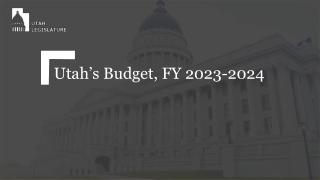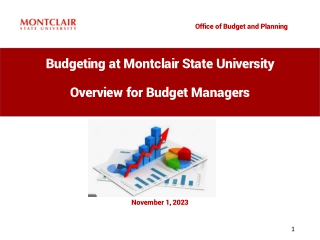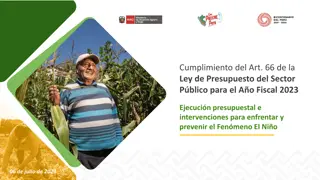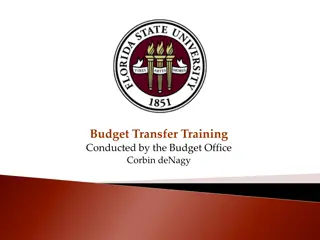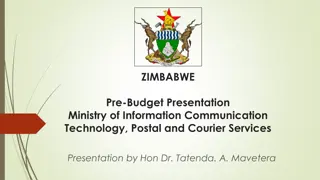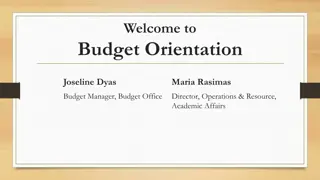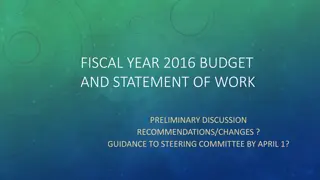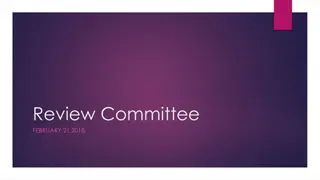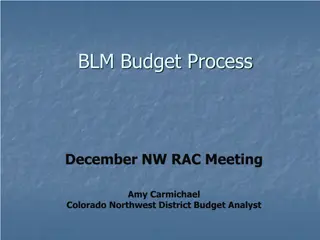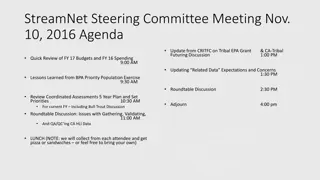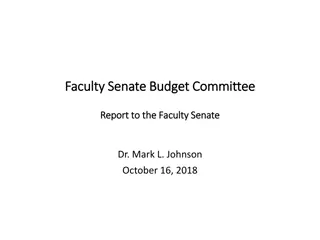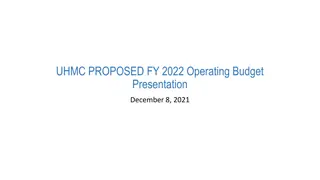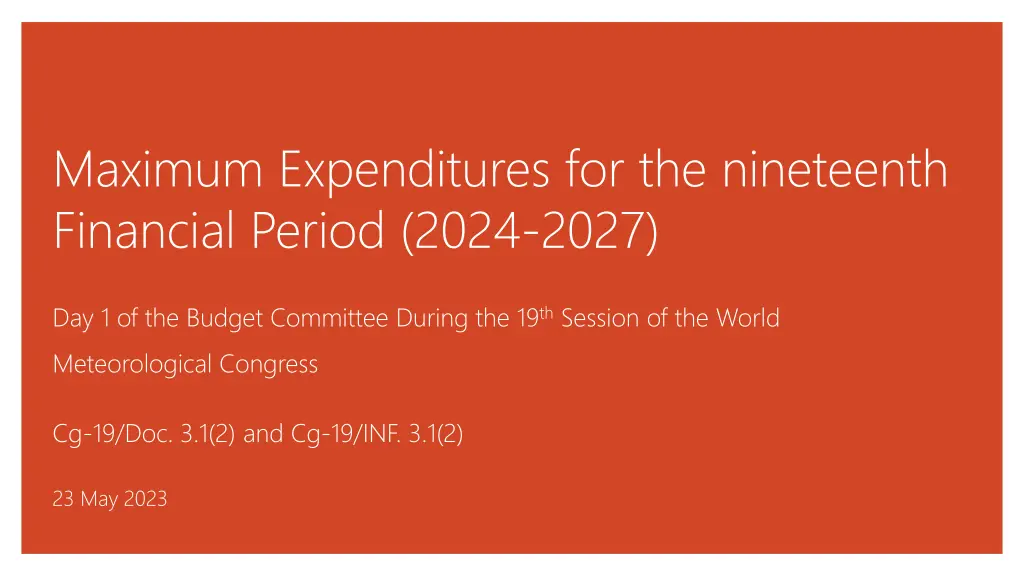
Maximum Expenditures for the 19th Financial Period 2024-2027 Overview
Explore the development process and recommendations made for the maximum expenditures during the 19th Financial Period 2024-2027. Discover details on scenarios, priorities, financial implications, and recommendations for enhanced program effectiveness and financial management.
Download Presentation

Please find below an Image/Link to download the presentation.
The content on the website is provided AS IS for your information and personal use only. It may not be sold, licensed, or shared on other websites without obtaining consent from the author. If you encounter any issues during the download, it is possible that the publisher has removed the file from their server.
You are allowed to download the files provided on this website for personal or commercial use, subject to the condition that they are used lawfully. All files are the property of their respective owners.
The content on the website is provided AS IS for your information and personal use only. It may not be sold, licensed, or shared on other websites without obtaining consent from the author.
E N D
Presentation Transcript
Maximum Expenditures for the nineteenth Financial Period (2024-2027) Day 1 of the Budget Committee During the 19thSession of the World Meteorological Congress Cg-19/Doc. 3.1(2) and Cg-19/INF. 3.1(2) 23 May 2023
Agenda Process to Date EC-76 (February 2023) Outcome FINAC-43 (May 2023) Observations Scenarios presented by the Secretary-General in Cg-19/INF 3.1(2) FINAC-43 requested information Open discussion 2
Process for Development of Maximum Expenditures 2024-2027 FINAC-41 EC-75/INF. 4(1d) EC-75 PAC EC-76/INF. 5 FINAC-42 EC-76 Cg-19/INF. 3.1(2) Maximum Expenditure document responding to consolidated recommendation in EC-76 13/1 FINAC-43 Congress-19 Decision making on Maximum Expenditure for financial period 2024 Decision making on Maximum Expenditure for financial period 2024- -2027 2027 3
EC-76 Recommendation 13/1 EC-76 recommended that the information document related to Maximum Expenditures 2024-2027: (a) Incorporates an additional maximum expenditure scenario based on ZRG, estimated to be CHF 278 071 400, taking into account inflation and energy price increases; (b) Reflects, in all scenarios presented, the United Nations (UN) Early Warnings for All initiative as an overarching priority for WMO; (c) Recognizes the importance of the replacement of the Enterprise Resource Planning (ERP) system and the implementation of the Information Technology (IT) Strategy in supporting the deployment of the WMO programme and for improving IT security and continues to limit the financial impact of these elements on the maximum expenditure for the nineteenth financial period through additional funding sources such as underspend from the eighteenth financial period and the Programme Support Cost Special Account; (d) Provides additional detail with respect to the financial implications of programmatic prioritizations made in moving from the ZNG scenario to the ZRG scenario and to any other scenario presented by the Secretary-General and information on what might be discontinued; 4
EC-76 Recommendation 13/1 EC-76 recommended that the information document related to Maximum Expenditures 2024-2027: (e) Provides additional detail and support with respect to the object of expenditure, with particular emphasis on the evolution of planned WMO Secretariat travel and consultant costs under the scenarios presented; and (f) Provides further information and efforts to mobilize resources with respect to voluntary and in-kind contributions, as well as other potential sources of funding, that could be utilized to close the gap between what is determined to be feasible and affordable by Members to be funded from assessed contributions and the additional priorities and demands being placed on WMO. EC-76 also recommended to Congress the adoption of the draft Resolution ##/1 (Cg-19) after deliberation during the nineteenth session of Congress. 5
FINAC-43 Observations 1. FINAC noted the the presentation of a Zero Nominal Growth (ZNG) scenario, a Zero Real Growth (ZRG) scenario and the Secretary-General s Proposal. 2. FINAC noted that the information document (Cg-19/INF 3.1(2)) addressed the recommendations of EC-76 in Recommendation 13/1 (EC-76) 3. The discussions during the FINAC meeting were primarily focused on the ZNG and ZRG scenarios, as well as the prioritization of the activities that could be funded within these two scenarios. Among the Members present at FINAC, it was stated that the final Maximum Expenditure level to be determined by Congress must balance the requirements being placed on WMO with the affordability for Members of the level of Maximum Expenditures 4. FINAC also requested the provision of specific additional information during the Budget Committee meetings at Congress 6
FINAC-43 Recommendations That Congress: (i) Discusses the proposed Maximum Expenditures for the nineteenth financial period, considering the prioritization of activities that can be funded under the scenarios presented, (ii)Encourages all Members to actively participate in the discussions during Congress, including during the Budget Committee meetings, to enable Congress to reach a consensus Maximum Expenditure amount, and (iii)Adopts Resolution 3.1(2)/1 (Cg-19) Maximum Expenditures for the nineteenth financial Period (2024 2027). 7
Maximum Expenditure Scenarios (2024-2027) Same nominal level as in 2020-2023; therefore, absorbing the impact of the inflation estimated to CHF 6.4 million and reducing programmatic funds available Zero Nominal Growth (ZNG) CHF 271.5 M Unable to finance most Key Priorities Areas 11,141 278,071 Zero Real Growth (ZRG) CHF 278.1 M (2.4% increase over ZNG) Considers inflation of CHF 6.5 million and provides initial funding for most key priority areas through de-prioritization of some core activities included in the ZNG scenario -4,614 271,544 ZNG Key Priority Areas De-prioritization ZRG Secretary-General s Proposal CHF 290.4 M (6.9% increase over ZNG) Considers inflation of CHF 6.8 million and more fully finances key priority areas and other programmatic initiatives without de- prioritization core activities considered in the ZNG scenario. 4,618 290,396 14,234 271,544 ZNG Key Priority Areas Addional initiatives SG's proposal 8
Incremental budget from ZNG to ZRG and SGs Proposal Scenarios (in CHF thousands) Element ZRG Scenario SG s Proposal Maximum Expenditure at ZNG 2024-2027 Incremental Early Warnings for All WMO-coordinated Greenhouse Gas Watch Regional and Representative Office Reform Plan of Action for Hydrology 271,544.4 2,570.5 1,899.9 2,225.1 865.8 271,544.4 2,570.5 2,649.9 3,210.3 865.8 1,357.2 Cryosphere and Downstream Impacts - De-prioritized activities to fund ZRG (4,614.3) 3,58- - ERP System and IT Strategy Implementation 3,58- 4,618.3 290,396.4 Additional Programmatic Requirements Maximum Expenditure Scenario 2024-2027 - 278,071.4 9
FINAC-43 requested information Actual Expenditures by Object of Expenditure 2020-2022 Key Priority Areas by Staff Cost vs. Non-Staff Cost across Scenarios Comparison of Staff Elements for Key Priority Areas across Scenarios Further details on Forecast Extrabudgetary Contributions Economies and efficiencies 10
Expenditure by Object 18th Financial Period (in CHF thousands) ZNG ZNG Scenario Scenario 73.7% ZRG ZRG Scenario Scenario 73.2% SG s SG s Proposal Proposal 71.9% Object of Expenditure Object of Expenditure 2020 2020 2021 2021 2022 2022 Staff costs 81.6% 67.5% 67.4% 4.5% 4.8% 5.1% Short-term staff and consultancy service 1.7% 7.2% 7.9% 5.8% 5.6% 6.4% Travel Experts 0.4% 0.2% 3.5% 1.6% 1.6% 1.7% Travel - Staff 0.4% 0.3% 2.4% 1.1% 0.9% 1.1% Fellowships and training activities 0.4% 0.6% 1.1% 1.9% 1.9% 2.0% Grants and financial contributions 2.3% 3.8% 4.3% 9.2% 9.9% 9.8% Contractual services and operating expenses 10.8% 18.1% 11.4% 2.2% 2.1% 2.0% Repayment of the loan for WMO HQ building 2.5% 2.4% 2.1% Total 100.0% 100.0% 100.0% 100.0% 100.0% 100.0% 11
Key Priority Area by cost category - ZRG Scenario (in CHF millions) EWS4All (**) EWS4All (**) GGH GGH Hydrology Hydrology RO Reform RO Reform ERP ERP IT Strategy IT Strategy De-prioritization De-prioritization staff staff non-staff non-staff staff staff non-staff non-staff staff staff non-staff non-staff staff staff non-staff non-staff staff staff non-staff non-staff staff staff non-staff non-staff staff staff non-staff non-staff LTG.1 LTG.2 LTG.3 LTG.4 LTG.5 Part VI Part VII Admin Total - 0.9 - - 0.9 (1 P4) - 0.2 - - - - - - (0.9) (*) 0.9 (1 P4) 0.5 1.2 (1 D1) 0.1 - - 0.2 - - - - - (1.0) (1 P5) (0.2) (*) - 0.2 0.7 (1 P3) - - - - - - - - - - (0.7) - 0.1 - - - - 1.4 0.3 - - - - (1.0) (1 P5) (0.9) (*) - - - - - - - - - - - - - - - - - - - - - - - - - - - - - - - - - - - - - - - - - - - - - - - - - - - 2.0 - 1.6 - - 0.9 1.7 1.8 0.1 0.9 - 1.9 0.3 - 2.0 - 1.6 (2.0) (2.6) 2.6 1.9 0.9 2.2 2.0 1.6 (4.6) (*) Overall Reform of the Regional Offices (multiples grades involved) (**) ZNG contains CHF 3.6 million financing EWS4All, this amounts is composed of CHF 1.0 million in staff cost (1 P5) and CHF 2.6 million in non-staff costs. 12
Key Priority Area by cost category SGs Proposal (in CHF millions) EWS4All (**) EWS4All (**) GGH GGH Hydrology Hydrology Cryosphere Cryosphere RO Reform RO Reform ERP ERP IT Strategy IT Strategy Additional initiatives Additional initiatives staff staff non-staff non-staff staff staff non-staff non-staff staff staff non-staff non-staff staff staff non-staff non-staff staff staff non-staff non-staff staff staff non-staff non-staff staff staff non-staff non-staff staff staff non-staff non-staff LTG.1 LTG.2 LTG.3 LTG.4 LTG.5 Part VI Part VII Admin Total - 0.9 - - 0.9 (1 P4) - 0.7 ( 1 P3) 0.7 0.4 - - - - - - 0.1 (*) 0.9 (1 P4) 0.5 1.2 (1 D1) 0.8 - - - - 0.4 - - - - - - 0.5 (*) - 0.2 0.7 (1 P3) - - - - - - - - - - - 0.9 (1 P4) 0.7 - 0.1 - - - - - - 2.2 0.3 - - - - - 0.9 (*) - - - - - - - - - - - - - - - 0.3 - - - - - - - - - - - - - - 0.7 (1 P3) 0.7 - - - - - - - - - - - - - - - - - - - - - - - - - - - 2.0 - 1.6 - - 0.9 1.7 1.8 0.8 0.9 - 0.7 0.7 2.9 0.3 - 2.0 - 1.6 1.6 3.1 2.6 2.6 0.9 1.4 3.2 2.0 1.6 4.6 (*) Overall Reform of the Regional Offices (multiples grades involved) (**) ZNG contains CHF 3.6 million financing EWS4All, this amounts is composed of CHF 1.0 million in staff cost (1 P5) and CHF 2.6 million in non-staff costs. 13
Additional details regarding extrabudgetary contributions (in CHF millions) Source Source CREWS EWS from Specific Members Climate and Adaptation Capacity Development / VCP JPO Programme SOFF Secretariat Infrastructure and Observing Systems Hydrology Research and Science Regional / Liaison Office Support Amount Amount 19.9 30.8 11.5 14.4 7.0 4.0 1.8 3.3 2.6 2.0 2.7 Others Total Total 100.0 100.0 14
Additional details regarding extrabudgetary contributions (in CHF millions) Source Source CREWS EWS from Specific Members Climate and Adaptation Capacity Development / VCP JPO Programme SOFF Secretariat Infrastructure and Observing Systems Hydrology Research and Science Regional / Liaison Office Support LTG 1 LTG 1 LTG 2 LTG 2 LTG 3 LTG 3 LTG 4 LTG 4 LTG 5 LTG 5 Part VI Part VI Part VII Part VII 10.6 23.8 9.3 0.3 3.9 - - 9.3 2.5 2.1 14.0 2.3 - - - - - - - - - - - - - - - - - - - - - - - - 3.0 0.1 0.1 0.6 4.0 1.8 0.8 1.5 - - 0.1 0.1 - - - - - - - - - - - 2.4 0.1 - - - - - - 2.6 - - - 1.1 0.3 31.7 31.7 0.9 0.3 1.3 1.3 2.0 2.0 2.0 0.1 0.1 0.1 Others Total Total 50.3 50.3 10.4 10.4 4.3 4.3 15
Economies and Efficiencies Efficiencies were realized in the 18th Financial Period through: These efficiencies were reinvested during the Financial Period through: Investment in mid-level Professional Staff with knowledge in critical areas Contributions to regional activities, primarily through the creation and filling of seven additional positions in Regional Offices 16
Economies and Efficiencies Review of administrative costs staff and non-staff Administrative staffing and non-staff costs were reviewed to determine overall need and appropriateness of funding source. Identified that some staff are significantly supporting extrabudgetary activities as an indirect cost. Operational costs also support extrabudgetary activities Review resulted in movement in funding of staff and non-staff costs out of Regular Budget to Programme Support Costs of approximately CHF 3.8 million Review of required / proposed staffing As an ongoing process staffing levels in each of the Departments is reviewed with focus on identifying what level of staffing is actually required to delivery on the Strategic Objectives as defined in the Strategic and Operating Plan. The review resulted in the identification of staffing needs to support each LTG / Appropriation Part and to identifying the staffing adjustments required for the implementation of the Key Priority Areas, with impact of CHF 2.0 million in administrative-related staff costs throughout WMO. 17
Economies and Efficiencies Consideration of method of implementation of activities During the planning process, WMO ensured any duplication to deliver the required outcomes was eliminated. WMO considered the most efficient and effective way of delivering the outputs identified. Examples include the use of virtual and hybrid meetings, the use of consultants where internal expertise is not needed in the long-term, etc. The financial implications of these decisions are not directly quantifiable; however, these decisions led to the ability of WMO to deliver the outputs as contained in the Operating Plan under the ZNG scenario. Consideration of impact of key supporting activities, including ERP and IT Strategy The investment in the ERP will bring improvements to business processes in a number of ways, including improved efficiency, improvements to internal control, improved project management and improved monitoring and reporting. The improvements in efficiency may result in long-term cost savings; however, the real benefit will be the improvements in the utility and fit-for-purpose nature of the system. The investment in the implementation of the IT Strategy is focused on digital transformation, increasing cybersecurity, reducing risk, supporting the business through information-based decision making. The IT Strategy also aims to increase efficiency and optimize WMO s investment in and support of the IT Systems. For both initiatives, long-term cost savings may be identified as the implementation proceeds and would likely be realized in future financial periods. 18

